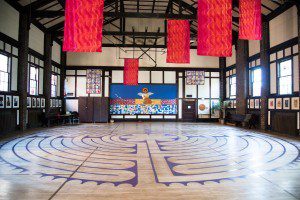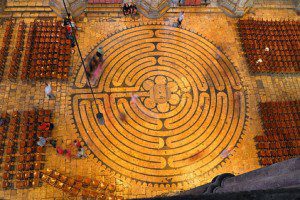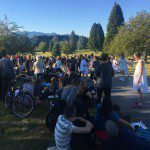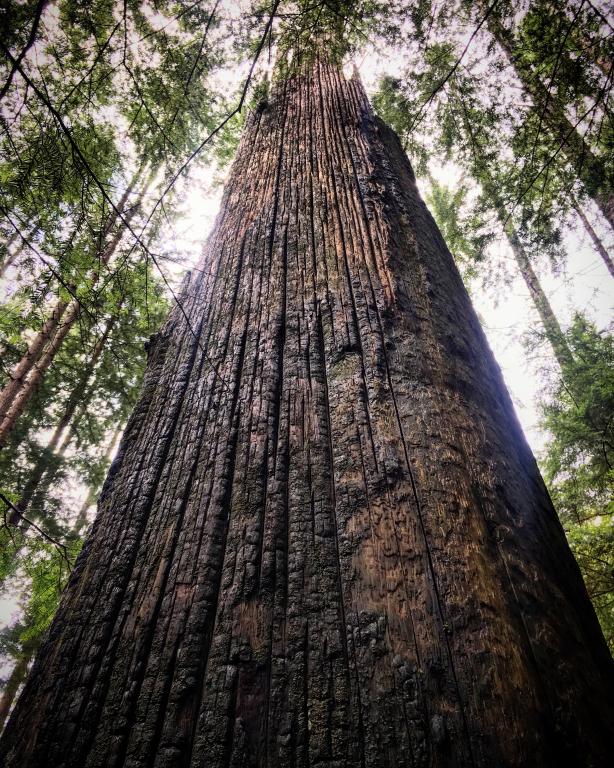
The soft staccato of a Celtic harp feels radically different from the bustling Friday night sounds of Davie Street. I sit, remove my shoes and socks and take a deep breath. I walk to the entrance of the labyrinth and center myself before taking short, slow and deliberate steps into the 11 course Labyrinth modeled after the famous Chartres Labyrinth in France. I am happy to be out of the hustle and noise of the city and to let my unhurried footsteps calm my heart and mind. I had just received news that my grandfather had just passed away and I would be heading back to California the next day, but I wanted to take a few moments before I left to pray.
Twice a month, Saint Paul’s Anglican Church on Jervis hosts this Labyrinth meditation. The Labyrinth is open other times during the week, but twice a month they invite a local musician to play while we walk the Labyrinth. I have found walking Labyrinths a good way to uncoil the stress and anxiety that I work myself into during the week.

Labyrinths appear to originate with the Greek myth of the artisan Daedalus who built the labyrinth for the King of Crete to contain the dreaded Minotaur, a creature with the head of a bull and the body of a human. Originally thought to be a multicursal like a maze with many paths, in its contemporary use, the Labyrinth is unicursal—one way in and one way out. The idea that a maze or labyrinth could contain evil spirits is common in ancient depictions. Labyrinths have been found in several 18th and 19th Scandinavian fishing villages, and the Topock Mazes in the California desert are claimed by the Mojave people to be road for the ancestors to the next world.
In the 1300s labyrinths began to be incorporated into sacred architecture and gardens, most notably the Chartres Cathedral in France. It is thought that perhaps they were a kind of sacred geometry, or aid in walking devotions. For those who could not make it all the way to the Holy Land, Labyrinths also served as a symbolic pilgrimage; and represent our journey to God. Contemporary use of Labyrinths focus on the kinesthetic practice of walking to aid in quieting the mind while doing contemplative prayer.
There were about five other people in various sections of labyrinth as I made my way to the center. I took my time and watched my breath and tried to feel my feet on the ground. I tried not to feel annoyed with the presence of other people and focus on my meditation. My mind would inevitably wander and I would come back to my breath, my feet and my prayer. Sometimes my awareness would come back and I would wonder if I was on the right path to the center. My mind would wander to the trip I had to make in the morning, wondering what buses I would take home tonight, what I still needed to get done before bed that night.
It occurred to me that the Labyrinth was not some separate spiritual practice that allowed me to more authentically connect to God, but rather was a kind of rehearsal for being present in all aspects of life. The buses and sidewalks that brought me here are Labyrinths. The faces and stories and lives I passed on the way here are Labyrinths. The sounds and smells and textures are all Labyrinths.
As I entered the middle of the Labyrinth, I closed my eyes and prayed in silence, resolving to take the Labyrinth with me when I left. As I walked onto the street from the quiet church, the sounds of the city overtook me. Keeping my attention on the breath, I walked slowly and deliberately toward Granville to catch a 4-Bus to the City Center Sky Train. I tried to acknowledge the diversity of faces I passed and hold eye contact for a little longer. I took in without craving or judgement storefront signs and window displays. I relished in the smells of food wafting from open patios. I touched the trunks of trees and watched the fluttering wings of doves, crows and pigeons that scuttled between rooftops to sidewalks.
I tend to feel as though my spiritual practices–prayer, meditation, yoga–are escapes from the day to day business of the world, and sometimes pause and escape are really important. But today, I realized that walking the Labyrinth is not just a de-stressing activity or a kind of body prayer, it is practice for the real work of being mindful to each moment and each encounter.












